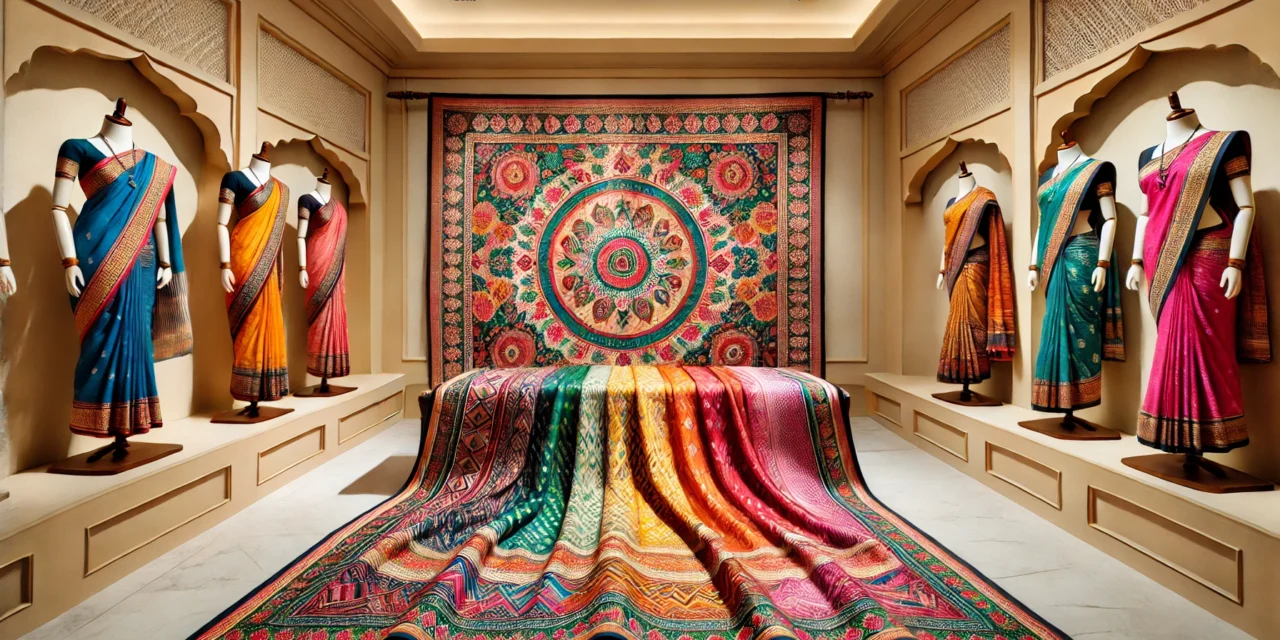Patola sarees are famed for their intricate designs and colors, showcasing the opulence of India’s heritage to textile. Known for their elegance, luxury and cultural relevance, these sarees belong to Patan in Gujarat. So, today we are going to explore the historical significance and cultural impact behind these fabulous silk sarees as well with a deeper dive into the awe-inspiring art of weaving patola.
Patola Sarees Revive The Rich Past
Origins and Evolution
Patola weaving has origins that date back to the 12th century. The Solanki dynasty patronized this artistic craft, which is said to have been introduced in Gujarat by the Salvi community who belonged to Southern Indian at that time. Patola comes from the Sanskrit word ‘Pattakulla’, which means silk fabric. Traditionally in history, these sarees were only for the royals and elite so it was a symbol of their status among society demonstrating wealth.
Cultural Significance
Undoubtedly, Patola sarees have been the lifeline of many communities in Gujarat. Azadegan for instance, it was prevalent among Jain and Hindu women who chose between parrots/floral designs/elephants/dancing figures with its Islamic counterpart further west – Muslim communities adopted khussa or aala pakka but preferring geometric patterns overlap by floral motifs. These sarees are traditionally worn by the bride during her marriage resulting in a bridal trousseau symbolizing good luck and fertility.
The Intricate Weaving Process
Double Ikat Technique
Patola Saree – Patola sarees are famous for their double ikat but instead of single Ikat in it both the wraps and weft threads are dyed. The whole operation is unbelievably laborious, considering one mistake could scrap the entire design. Threads are then dyed with mushru in various natural colors including indigo, turmeric, marigold and henna.
Craftsmanship
The production of even a single Patola saree can take around six months to one year depending on the intricacy. Weaving requires great skill and concentration, making Patola sarees an extraordinary piece of art as well as a testament to the devotion and proficiency of its weaver. All the sarees are double sided and have the same designs on both sides, which shows their weaver skill .
Iconic Patola Designs
Traditional Motifs
There are a plethora of traditional motifs, which come from different parts of the state and each with its own cultural significance that can be seen in styles like bandhani, patola etc. Typical patterns include human figures, elephants, flowers and geometric shapes. These patterns draw from the cultural and religious traditions of the communities that create them. I.e. the design ‘Nari Kunj’ showing dancing women is a favorite of all gujarati ladies for example
Modern Interpretations
Even though conventional motifs still tend to dominate, contemporary Patola sarees have taken a whiff of modernity. Designs are tested with varied color mixes and patterns to suit the appetites of changing tastes & trends. With all these innovations, the soul of Patola weaving is still there and which makes it evergreen.
The Legacy of Patola Weaving
Preservation Efforts
Patola weaving is practiced by a handful of families in Patan, where the intricate art has been passed down from one generation to another. Measures to save this legacy have included arranging historical centers and completing live weaving exhibitions. These projects help to promote the level of interest and appreciation for this wonderful craft, which in turn helps secure its future as well.
The Contemporary Patola
Patola Sarees will always remain dear to the hearts of fashion connoisseurs. The vibrant colors, detailed patterns and lush fabric make them one of the go-to options for weddings. Celebrities and fashion stylists have made their preferences when they don a Patola saree, reflect simplicity while still being exquisite.
Styling Your Patola Saree
Traditional Accessories
Classic Indian jewelry like gold necklaces, silver earrings and bangles add a touch of tradition to the intricate designs on Patola sarees. These accessories lend a decadent feel to the saree and make your trousseau utterly extravagant.
Contemporary Twist
Patola sarees can be teamed with simpler jewelry or western style accessories to funk it up a bit nowadays. The result is a stylish mix that melds generations of craftsmanship with fashion-forward innovation for those who want tradition updated.
Also Read: Understanding Ram Shalaka: An Ancient Divination Tool
Conclusion
Now that patola sarees-online have begun to make a comeback so soon after their downfall, we can only hope for the best and think positively of them. Modern-day patolas are no longer just clothing; they represent centuries-old tradition values embedded in every weave. The designs, colors and historical context of the creation make them a timeless work that – even today – is adored by generations. These Patola sarees are worn by women on a special occasion or these can be passed down as an ancestral gift, wherever it may see its future from what is certain the admiration passes through time to reach us here today weaving between past and present illustrating artistry at best of times.










